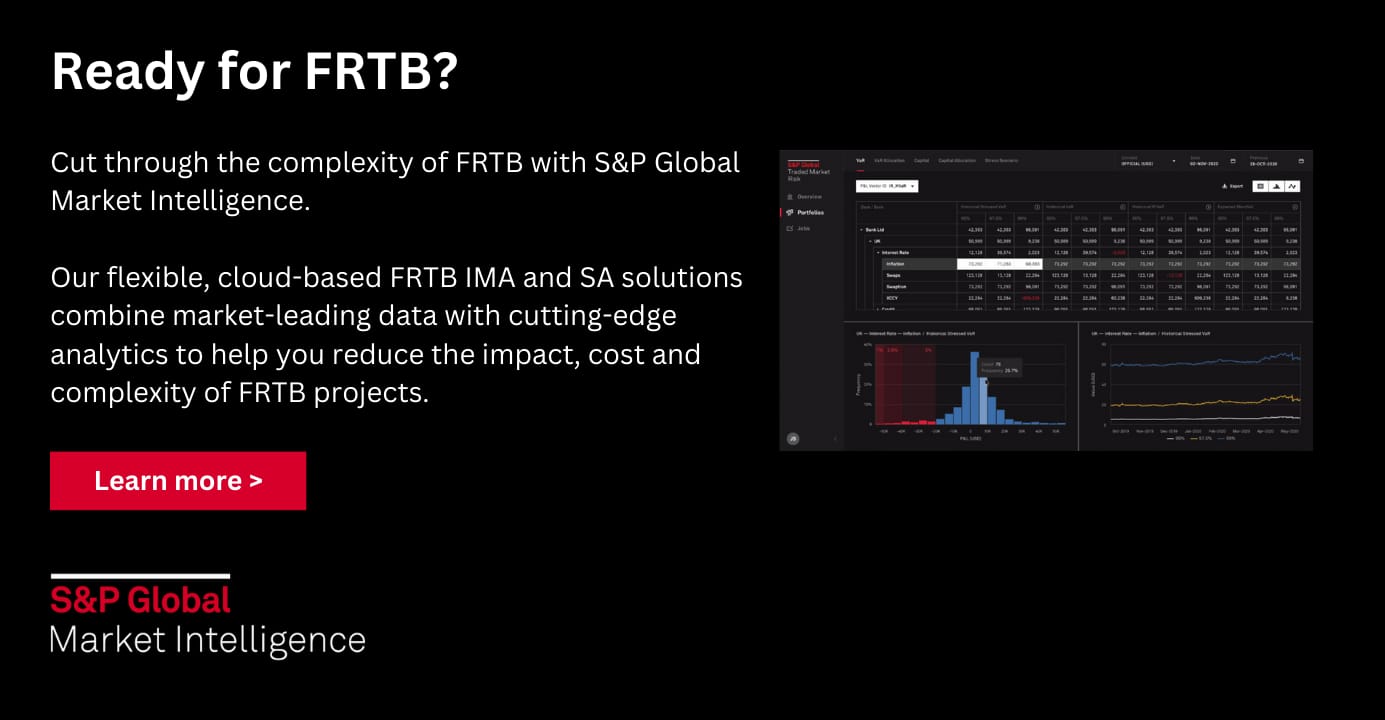FRTB: 6 reasons to consider adopting the Internal Model Approach
Fundamental Review of the Trading Book (FRTB) regulations are designed to improve the resilience of banks' trading activities by ensuring that they have sufficient capital to cover potential losses. The regulations aim to prevent a repetition of the financial crisis of 2008 and to make the banking system more stable. Additionally, non-compliance with the regulations can result in fines and penalties from the regulatory authorities.
Banks' significant Trading Book losses during the 2008 financial crisis demonstrated that the overall market-risk capital framework was unable to absorb losses during significant market stress. This is partly due to the fact that, while the Basel 3 VaR modelling approach did a decent job of modelling risk under normal market circumstances, it did a pretty average job of capturing extreme tail risk. Expected Shortfall (ES) comes into play at this point, and no bank seems to dispute that it is a welcome change.
However, FRTB is more than a switch to ES. It also includes a few other components that are crucial to the banking industry's resilience. For instance:
- No more "blurry" boundaries that lead to disputed decisions in the Banking Book (BB) and Trading Book (TB) classification.
- The assumption that all positions can be liquidated within a 10-day horizon without having a significant impact on price turned out to be incorrect, necessitating a more cautious approach.
Why should banks apply for FRTB-IMA and not settle for SA?
Reason #1
First, the difference between the Internal Model Approach (IMA) and the Standardized Approach (SA) under the Fundamental Review of the Trading Book (FRTB) regulations lies in the level of complexity and flexibility of the methods used to calculate a bank's capital requirements for market risk.
IMA allows banks to use their own internal models to calculate their capital requirements, as long as they are approved by the relevant regulatory authority. This approach is generally seen as more flexible and elaborated, as it allows banks to use models that are tailored to their specific risk profile. However, it also requires more complex and sophisticated risk management systems, as well as a higher level of expertise in modeling and validation.
SA, on the other hand, is a simpler approach that uses pre-set risk weights and formulas to calculate capital requirements. It is generally seen as less flexible than the IMA, as it does not consider the specific risk profile of a bank. However, it is also less complex and may be more appropriate for smaller or less sophisticated banks.
Reason #2
Because FRTB is not merely a capital optimisation exercise and behind it lies a need for better models and practices to manage market risk. These improved models require a revamp of the banks' infrastructure which, with many banks, is long overdue - so FRTB is a good "excuse" to get from management the budget required for an infrastructure overhaul (and for banks already having state of the art infrastructure, that means they are IMA banks by nature).
Reason #3
Because even if, not just for sake of argument, it was just a capital optimisation exercise and banks analysis show that the capital saving of going IMA vs. SA does not justify the cost, it is most likely considering the endgame of the 72.5% floor. However, the 72.5% floor will be reached only after 5 years (depending on local regulation), starting with a floor of 50%, gradually increasing up to 72.5%: there is room for more benefit of IMA vs. SA in the first 2-3 years. This will obviously vary between banks, depending on their Market Risk Weighted Assets (RWA), but banks with double-digit ratio of Market RWA out of the total RWA are very likely to see capital benefit from going IMA, even though with a single stack floor, banks with high Credit RWA will most likely see most of the benefit "swallowed" by it.
At last, more than often, the conclusion on comparing IMA vs. SA capital not justifying the cost is based on using banks' own data and not enough vendor data, thus getting too high level of NMRF leading to too high level of SES charge leading to IMA supposedly being not worth it.
Reason #4
Because for banks with sophisticated trading books, not going IMA may pose a reputational risk to the bank vis-à-vis both regulators and investors, especially for banks using an internal model under Basel 3.
Reason #5
Because if we extrapolate the "trend" of not applying for IMA, it will take us to too many banks being SA which will create an unwelcome consequence of "opting out" of different markets that they were traditionally active in. This will reduce banks' appetite to inject liquidity into the market during periods of turbulence or stress. If previous liquidity crises were characterized by a genuine lack of funds, we could find ourselves having the next liquidity crisis be a result of banks' lack of ability or desire to deploy the funds at their disposal. Not only that, if all banks were to employ the same standardised approach, it may cause many banks to move together and thus create an undesirable clustering effect and an impairment to market liquidity.
Reason #6
Because data governance is lacking with many banks and few reports generated by regulators indicate insufficient compliance with BCBS239 ("Principles for effective risk data aggregation and risk reporting") and so applying IMA approach and in particular the 7 principles stipulated in MAR31.26 (p.k.a. Annex D) will be a good opportunity for the banks to improve their data governance.
In conclusion
The FRTB IMA and SA frameworks are both crucial in determining the capital requirements for market risk in banking institutions. The IMA framework provides a more flexible and granular approach to calculating risk-weighted assets, while the SA framework is the simpler approach. Both have their advantages and disadvantages, but it is important for banks to understand the differences between them and choose the framework that best suits their risk profile. The ultimate goal is to ensure that banks have sufficient capital to withstand market risks.
About Traded Market Risk from S&P Global Market Intelligence
The Traded Market Risk Solution from S&P Global Market Intelligence combines a risk calculation engine with data and data modelling. The solution helps clients compute Capital requirements in both Standardised Approach (SA) and Internal Model Approach (IMA). FRTB requires a significant investment of time, money and resources from banks as it involves an overhaul of infrastructure and processes in order to manage the requirements. IMA eligibility is now subject to individual desk-level approval with more rigorous performance testing, intraday market risk monitoring and a much stricter data and governance model required.
The solution is differentiated by allowing for a single infrastructure across FRTB-TB and FRTB-CVA and an open cloud-native approach. The FRTB modellability service leverages 100+ million RPOs across all asset classes (IR, FX, FI, CR, EQ, CO) that curates, normalizes and enriches real price observations (RPO) with reference data to make them easy to use. It's a turn-key solution that is simple to integrate with pre-defined modellability configurations defined by our FRTB SMEs. The methodology can be easily configured for bespoke modellability results.
Learn more about the FRTB Modellabilty Service from S&P Global Market Intelligence.
S&P Global provides industry-leading data, software and technology platforms and managed services to tackle some of the most difficult challenges in financial markets. We help our customers better understand complicated markets, reduce risk, operate more efficiently and comply with financial regulation.
This article was published by S&P Global Market Intelligence and not by S&P Global Ratings, which is a separately managed division of S&P Global.

